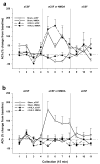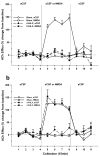Disruption of mesolimbic regulation of prefrontal cholinergic transmission in an animal model of schizophrenia and normalization by chronic clozapine treatment
- PMID: 19693002
- PMCID: PMC2783192
- DOI: 10.1038/npp.2009.105
Disruption of mesolimbic regulation of prefrontal cholinergic transmission in an animal model of schizophrenia and normalization by chronic clozapine treatment
Abstract
Abnormal mesolimbic control of cortical cholinergic activity has been hypothesized to contribute to the cognitive symptoms of schizophrenia. Stimulation of NMDA receptors in nucleus accumbens (NAC) increases acetylcholine (ACh) release in prefrontal cortex (PFC), an activation thought to contribute to attentional processing. Thus, the effects of intra-NAC perfusion of NMDA (250-400 microM) on ACh release in PFC were determined in rats receiving lesions of the ventral hippocampus (VH) as neonates (nVHLX), a neurodevelopmental model of schizophrenia, or as adults (aVHLX). NMDA elevated ACh release (100-150% above baseline) in adults sham-lesioned as neonates or in aVHLX rats. Adult nVHLX were unresponsive to NAC NMDA receptor stimulation. The inability of nVHLX to respond to NMDA emerged over development as a separate experiment demonstrated that evoked ACh release was normal before puberty (100-150% increase) yet, in these same nVHLX animals, absent after puberty. Amphetamine-evoked ACh release was assessed in nVHLX animals to exclude potential limitations in release capacity. Amphetamine produced greater increases in ACh release than in shams, indicating that nVHLX does not impair the capacity of cholinergic neurons to release ACh. Finally, the ability of 13 days of pretreatment with clozapine (1.25 mg/kg/day) to reinstate NMDA-evoked cortical ACh efflux was determined. Clozapine treatment normalized NMDA-evoked ACh release in nVHLX animals. These experiments show that mesolimbic regulation of cortical ACh release is disrupted in postpubertal nVHLX rats and normalized by low-dose treatment of clozapine; supporting the usefulness of nVHLX animals for research on the neuronal mechanisms underlying the cognitive symptoms of schizophrenia.
Conflict of interest statement
The authors have nothing to disclose nor are there conflicts of interest in matters associated with the experiments presented in this manuscript.
Figures






References
-
- Arnold HM, Nelson CL, Neigh GH, Sarter M, Bruno JP. Systemic and intra-accumbens administration of amphetamine differentially affects cortical acetylcholine release. Neuroscience. 2000;96:675–85. - PubMed
-
- Bhardwaj SK, Beaudry G, Quirion R, Levesque D, Srivastava LK. Neonatal ventral hippocampus lesion leads to reductions in nerve growth factor inducible-B mRNA in the prefrontal cortex and increased amphetamine response in the nucleus accumbens and dorsal striatum. Neuroscience. 2003;122:669–676. - PubMed
-
- Braff DL, Light GA. Preattentional and attentional cognitive deficits as targets for treating schizophrenia. Psychopharmacology (Berl) 2004;174:75–85. - PubMed
Publication types
MeSH terms
Substances
Grants and funding
LinkOut - more resources
Full Text Sources
Medical
Miscellaneous

